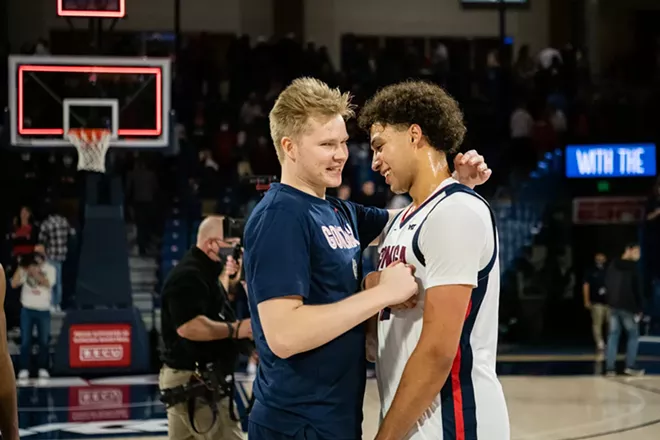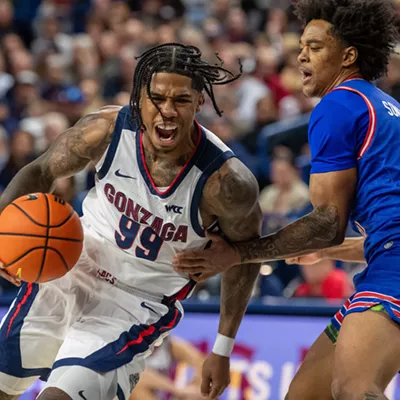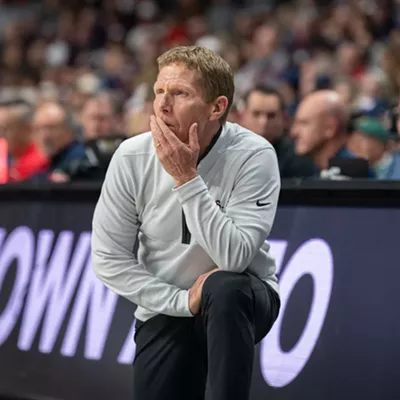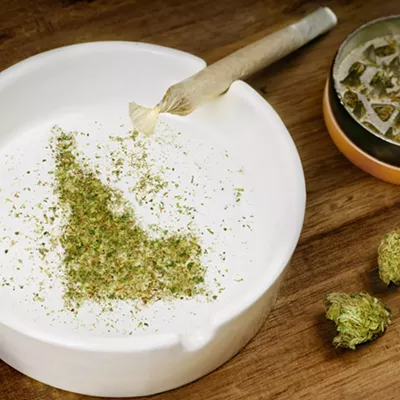It is now the home stretch of the regular season, with Selection Sunday less than a month away, and teams across the country are starting the sprint towards March. Are the Zags a well-oiled machine ready to cruise into the madness, or are there still some lingering issues that could cause them to crash and burn before the finish line?
To answer that, let’s take a look at three of the most obvious, and fixable, issues that the team has faced over the course of the season and see if they’ve been resolved.
THREE POINT SHOOTING
This season, college teams are averaging 33.6 percent from three point range, in games between two Division I opponents, according to statistician Ken Pomeroy. For the first 10 games of the season, more than one third of the way through the regular season, Gonzaga’s three point shooting numbers were on the wrong side of that average.
Over those first 10 games, the Zags connected on just 32.9 percent of their threes. If the season had ended then, that would’ve been the worst three-point percentage for a Gonzaga team not just in recent memory, not just under Mark Few, but rather the worst in the history of the program.
In the 13 games since, the Zags have made 42.2 percent of their threes. Almost a ten percentage point increase over the first month of the season. Their improvement has been so staggering that the Zags, for the entire season, now rank 17th nationally in three point percentage at 38.3 percent.
This development didn’t arise simply because Gonzaga is now playing West Coast Conference teams. The Zags’ opponents didn’t get worse, but rather the Zags simply got better.
Chet Holmgren (46.6 percent) has started knocking them down with confidence in the half-court, something he struggled with early. Julian Strawther (39.3 percent) has shaken off some of the streakiness he showed over the first month and found more of a regular rhythm. Andrew Nembhard (33.7 percent), on the other hand, has found a bit of positive streakiness that had until recently eluded him — though he is still liable to go 1 for 8 like he did last week against Pacific. Then there’s Rasir Bolton (45.8 percent), who has been the team’s most consistent shooter all season long, who has just kept chugging along.
TURNOVERS
In the first loss of the season, against Duke on November 26, the Zags turned the ball over 17 times. More than one-fifth of Gonzaga’s possessions resulted in a turnover. Duke’s really good, though.
The same can’t be said about Merrimack or Tarleton State, a pair of teams so new to the Division I level that neither is yet eligible for the NCAA Tournament. Against those two, the Zags turned it over 17 and 16 times, respectively. Nearly one quarter of Gonzaga’s possessions against those two teams resulted in a turnover.
In those three games, the worst of the season in this category, Gonzaga’s three rotation big men — Drew Timme, Chet Holmgren and Anton Watson — were largely to blame. Against Tarleton State, they accounted for 8 of the team’s 16 turnovers. Against Merrimack, it was 9 of 17. Against Duke, 10 of 17.
For simplicity’s sake, using the same window of time as we did for three point shooting, the bigs have made a dramatic improvement. They combined to average 6.6 turnovers per game over the first 10 games. Since, they’re averaging just 5.3 turnovers per game. That might not seem like much, but Gonzaga’s playing much faster than they were early on. The Zags are playing more possessions each game, which should lead to more turnovers, but the opposite has happened.
Now, I would be remiss if I didn’t mention point guard play in a section about turnovers. Andrew Nembhard was turning the ball over 2.5 times per game in those first 10 games. Since then, just 1.1 times a game.
DEFENSE
Of the discernable issues with the Zags, this one is the biggest stretch. It hasn’t actually been an issue, though at times it has looked like one.
Like when the Zags gave up 83 points at home to Pepperdine, the worst team in the WCC. Or when, in the very next game, they let a broken BYU offense put up 84 points, also at home. Or the game after that, when Santa Clara scored 83 on the Zags. Or two weeks later, when long-lowly Portland dropped 72 in The Kennel.
Well, Gonzaga scored over 100 points in each of those games, so what does it matter that they gave up as many points as they did?
Those four games were incredibly up-tempo affairs. Gonzaga played a program record (for a non-overtime game) 90 possessions against both Pepperdine and Santa Clara. Against Portland they tallied 84, and against BYU 78. Some quick mental math will show that of those four, only BYU scored above one point per possession.
On the whole of the season, only four teams have scored above one point per possession on Gonzaga: Texas, Alabama, BYU and Duke. When BYU got its rematch against the Zags down in Provo earlier this month, the Cougars managed just 0.697 points per possession.
Defense was included because it’s looked like an issue at times, even if it hasn’t been one, but also because of the rule of threes. Everybody loves things that come in threes. And speaking of three, that’s where the Zags rank nationally in defensive efficiency this season, per Sports-Reference. Through 23 games, which is no small sample size, teams have averaged a paltry 0.860 points per possession against the Zags.
UP NEXT
Gonzaga’s schedule gets a bit wonky this week, as they travel south to Malibu to face Pepperdine on Wednesday. That’s right, no traditional Thursday game this week, so make sure your calendars are appropriately updated. That one will air on ESPN2 at 8 p.m.
Saturday will see the Zags welcome a rapidly-rising Santa Clara squad to Spokane for the final home game of the season. Senior night against the Broncos gets underway at 6 p.m. and will air locally on FOX 28 and regionally on ROOT Sports.





















